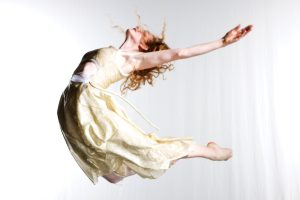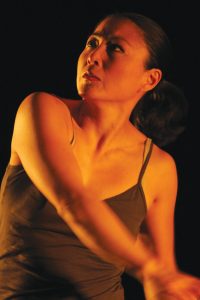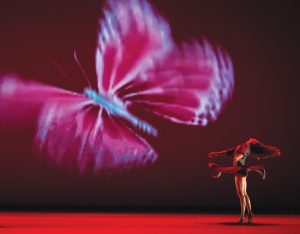Parallel Tracks: Academia and the professional stage - Vancouver Ballet Society
- Home
- Features 2015 - 2019
- Parallel Tracks: Academia and the professional stage

by Gigi Berardi
Top-flight dance artists can also be high-powered academics. Several artistic directors-cum-professors from around North America show a variety of ways to navigate that double path. For their companies, they direct, manage, fundraise, book gigs and rehearse dancers. Their academic jobs require them to plan lectures, grade final exams and sit on curriculum committees. They are chairs, co-ordinators and deans, and many of them came to their respective academic institutions by chance.

Photo: David Hou
David Roussève, who had performed in the companies of Kathryn Posin, Senta Driver, Jean Erdman and others, was on tour with his own company in 1995 when he heard about an opening at the University of California, Los Angeles, in the world arts and culture department. “I was ready for a change,” says Roussève. “I really enjoyed touring, but touring year-round made me feel ungrounded.”
For Roussève, as for most dance academics, the change came with concerns over how his identity as a professional dance artist could be maintained. Roussève says, “I didn’t want to be known as a nonworking artist. Still, there is no good reason why artists shouldn’t work in academe.” A big plus for Roussève was that at UCLA he would be close to a ready source of highly capable dancers. “In our MFA program, we have a lot of professionals — these are some of the strongest dancers I have seen.”
Judith Garay had guested at Simon Fraser University for a semester before she accepted a position in 1992 in its School for the Contemporary Arts, now in downtown Vancouver. A few years earlier, she had retired as a principal dancer with the Martha Graham Dance Company and moved back to Canada. Garay appreciated the fact that “SFU was attracting very interesting and interested students — really thinking people and artists.” If she was ever to teach, she felt, this was the right place.
Garay employs several SFU graduates in her company, Dancers Dancing, and has worked with some for more than a decade. Also, an apprentice program that awards university credit feeds into several area companies, including Dancers Dancing. Says Garay: “It’s a win-win situation, you know the students and you know their work ethic; in turn, they learn so much working with professionals.”

Photo: John Maniaci
Li Chiao-Ping had earned a master’s in dance from UCLA, and had danced with Sarah Elgart and Dancers in Los Angeles before accepting a faculty position in 1989 at Hollins University in Roanoke, Virginia. In 1993, she moved to the University of Wisconsin, Madison, where recently she was offered the prestigious Romnes Award and Vilas Research Professorship. Throughout her academic years, she has continued to direct her company, Li Chiao-Ping Dance, which is currently based in Madison.
Li occasionally works with students as company members, and believes there are great benefits to this arrangement. For the students, “it provides a close view of professional dancers and faculty who are actively engaged in the field,” says Li. For the university, “it’s a possible recruitment angle.”
Scholarly and professional productivity among faculty remains a requirement of higher education. When professional dancers take academic jobs, typically they stipulate that their creative output in their dance companies must be accepted as part of their academic “research” obligations. Says Li, “When I was hired as an assistant professor, it was understood that my area of research was, in fact, my creative work. It was extremely important to me that my choreography and performance be part of my job as a professor rather than viewed as a hobby or outside my job duties.”
Garay, too, believes strongly that “creative works need to be considered the equal of academic research.” These dancers-cum-teachers’ creative output is an important part of their quest for identity, and they do not want to relinquish their professional dancer persona.
Typically, the company and the university remain separate entities financially. Garay’s company is run as a not-for-profit charity, allowing her to apply for government grants, but, she says, “a somewhat unsettling challenge has been the discrimination by some arts funding juries due to my teaching position. It is perceived that the university should be supporting my work.” Li also has experienced discrimination over her double role: “I remember auditioning with my company for a New York venue, and hearing a clear bias from a panelist that I was a university professor, meaning I was somehow less of an artist.”

Photo: Frank Bicking
Kun-Yang Lin, a former dancer with Martha Graham, as well as with Doris Humphrey, Anna Sokolow and Jennifer Muller, directs Kun-Yang Lin/Dancers and is a professor in the Boyer College of Music and Dance at Temple University in Philadelphia. He was at a critical juncture in his life in 2001-2002, transformed by the events around 9/11, the sudden death of his father and the discovery that he himself had a brain tumour. Confronted with such loss and sense of mortality, he began to question what directions he wanted to take, recognizing a “need to pass on to the next generation, to my students and the community, whatever gifts had been given to me.”
Today, Lin views his company as a vehicle for mentorship and development, and for “providing a real-world bridge that is very much in line with Temple University’s commitment to ‘real-world ready.’” Lin believes every dance program should have artistic directors on its faculty roster; this “serves as an inspiring motivator for those students and potential students who want to pursue a career as professional dance artists.” A number of his current company members are graduates of the Temple dance program.
Some dancer-professors continue to work as independent artists — choreographing and producing — while directing student-based companies within university dance programs. For example, Holly Small, a professor of dance in the School of the Arts, Media, Performance and Design at Toronto’s York University, directed the York Dance Ensemble for 15 seasons, culminating in its 25th anniversary in 2013 with Rite Redux, a uniquely Canadian re-creation of the Rite of Spring. Still, “My own work also is a priority — it’s part of my drive,” says Small. “It’s a compulsion, I guess. I’m really a creature of the theatre and it gives me tremendous joy to make work with brilliant people.” Administrative duties tend to add up for tenured faculty like Small, and her academic year is filled with departmental service activities and teaching in both BFA and MFA programs. Small’s more ambitious work is created during professional leaves.
Given administrative and other time constraints, these dancers’ own companies are often “project-based.” As Roussève says, “The projects [for his company, REALITY] follow one after the other, and actually are developed over several years.” For example, he started developing material in 2009 for the premiere, five years later, of his evening-length piece, Stardust. Roussève, who now serves as interim dean of the School of the Arts and Architecture at UCLA, says, “It’s a struggle to find the hours in the day. I have to fight to make sure my choreography receives the attention it deserves.”
“The amount of time required for teaching, administrative and advising responsibilities at the university is substantial,” says Lin. “It is particularly challenging with respect to touring; from time to time my company has had to forego an opportunity due to my inability to be away from the university for an extended period.”
Li, who has served as department chair, agrees: “Juggling responsibilities is a constant struggle. I want to do all perfectly and give everything my attention. Since that is not possible, something is always giving. Sometimes, that’s me. Physically, I don’t have as much time or give myself as much time as I should.”

Photo: Chris Randle
Despite the challenges — one of which is very competitive internal university funding for creative work — there are advantages to working in academia. One, of course, is the regular salary and benefits, including paid periods of professional leave. There are creative advantages, too. “I am surrounded by faculty-based artists who give me feedback so that I am constantly reflecting on and examining my work,” says Roussève. “I’m almost relentlessly asked by colleagues to define, to qualify, to quantify.”
For Garay, working with dancers and other artistic collaborators is a thrilling two-way exchange of energy, information and inspiration that inspires her to teach with passion and integrity — and it seems to suit the dancers, too. Many former company members have been successful in forming their own groups and teaching at different universities.
The benefits of working with professional artists are substantial for dance students who choose to go the university route. With professional dancers as accessible role models, they learn real-world skills and are in the right environment to make both intellectual and artistic breakthroughs. They have time (and earn credit) to explore and reflect upon their training and choreography. Once they graduate, the dancers are well situated to audition and dance in whatever space and for whichever audiences they can find.

